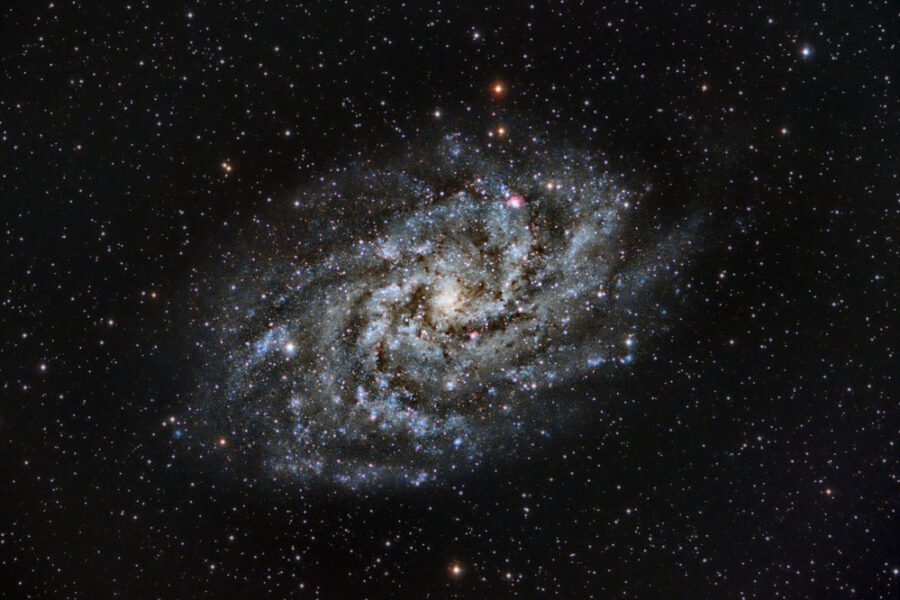Astronomers have discovered that one of the Milky Way’s nearest galactic neighbors has dramatically changed its looks in the recent past.
Messier 33, the Triangulum Galaxy, is a respectably sized stellar metropolis. With a total mass of perhaps several hundreds of billions of suns, it’s one of the largest galaxies in the Local Group, ranking just after Andromeda and the Milky Way in heft and vying with the Large Magellanic Cloud. It’s Andromeda’s largest companion, just as the LMC is ours.
But the LMC and its tagalong, the Small Magellanic Cloud, are “absolute train wrecks,” said Adam Smercina (University of Washington) — they’re messy, irregular mélanges of stars and gas, distorted by each other and the Milky Way. M33, on the other hand, is an elegant flocculent dwarf spiral, a wooly-looking disk with many arm segments.

M33 presents a unique opportunity to study spirals. The smallest star-forming dwarfs tend to be shapeless mishmashes of stars and gas — much different that the beautiful, sweeping arms of their larger cousins. Large, undisturbed dwarf spirals like M33 thus are a stepping stone that could help us understand how these patterns form and change.
To that end, astronomers looked at M33 with the Hubble Space Telescope in an extension of an Andromeda study called the Panchromatic Hubble Andromeda Treasury (PHAT). The new project is the Panchromatic Hubble Andromeda Treasury: Triangulum Extended Region, or PHATTER. (No comment.) Both projects have spent extensive time pointing Hubble section by section at their target galaxy. In PHATTER’s case, the researchers created a mosaic of the galaxy’s innermost 10,000 or so light-years by combining 54 individual Hubble fields. (The telescope’s field of view is a lot smaller than the 1° the galaxy spans on the sky.) These images reveal some 22 million stars in M33 as gleaming individual pinpricks.
The team split these stars into four groups by age: those less than 100 million years old, those several hundreds of millions of years old, those about 1 billion years old, and finally those at least several billion years old. Then they looked at the patterns each of these populations traced.
This is where things took an unexpected turn: The youngest stars traced the familiar fluffy, many-armed spiral. But the two groups of older stars outlined a two-armed, grand design spiral with a central bar. The sort-of young stars are somewhere in between. “The structure of M33 really depends on the stellar population that you’re looking at,” Smercina summed up during a press conference January 11th at the winter American Astronomical Society Meeting in Seattle.

The researchers saw early signs of this hidden structure in 2021. The more detailed analysis, which they’re writing up now in a new paper, confirms the barred, two-arm pattern and connects it to the galaxy’s structure on larger scales.
The old stars may not have been born tracing the grander pattern, Smercina explained. Rather, something could have happened after their birth to rearrange them. Observations at multiple wavelengths of both stars and gas in M33’s outskirts indicate the galaxy has a large warp, and the spiral arms also show some kind of asymmetry. “All of the evidence is pointing to M33 hitting something or interacting with something not super long ago,” he said. Tidal forces from this encounter could have sent waves rippling through the disk, spurring a two-armed spiral. Stars born long after the event wouldn’t have been rejiggered, explaining why today’s disk looks so different.
Alternatively, the two-armed spiral could in fact be a long-lived, dominant pattern only recently obscured by gas and the youngest stars. And it’s not that the ancient arms have totally disappeared. “Young stars do form there,” Smercina said. “It’s just they also form other places, too.” For whatever reason, the gas may have adopted a different structure than the underlying waves propagating through the disk.
Work is under way to investigate the PHATTER stars spectroscopically, to determine how they move through space. Any patterns in that motion might help suss out why M33 has changed its face.
References:
Smercina, A. et al. “The Structure of the Triangulum Galaxy in Stellar Populations Surveyed by the Hubble Space Telescope.” AAS 241, abstract 319.04. January 11, 2023.
Williams, B. F. et al. “The Panchromatic Hubble Andromeda Treasury: Triangulum Extended Region (PHATTER) I. Ultraviolet to Infrared Photometry of 22 Million Stars in M33.” Astrophysical Journal Supplement Series. April 2021.
 1
1









Comments
Anthony Barreiro
January 17, 2023 at 7:23 pm
"Work is under way to investigate the PHATTER stars spectroscopically, to determine how they move through space."
I hope they call it the Panchromatic Hubble Andromeda Treasury: Triangulum Extended Spectroscopic Triangulation.
You must be logged in to post a comment.
You must be logged in to post a comment.